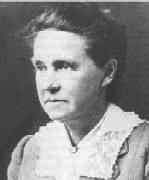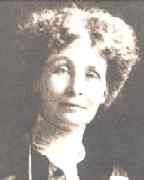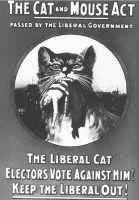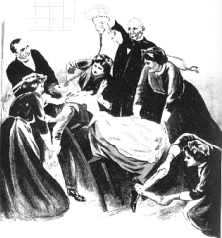Suffragist groups wished to campaign for women's suffrage by peaceful, moderate and law-abiding methods. In England, Millicent Garrett Fawcett founded the National Union of Women's Suffrage Societies (NUWSS) in 1897 to unite these various groups. By 1914 about 400 societies and over 20,000 people had joined.
|
They lobbied MPs and tried to persuade people that, in justice and fairness, women should be allowed to vote. Many believed the Liberal Party would be sympathetic. They supported the party by canvassing and fund-raising, so when the Liberals swept to power with a large majority in 1906 the NUWSS were understandably optimistic.
However, they were disillusioned and every effort made to persuade the new government to give votes to women failed. Many Liberal voters and MPs were believed to be in sympathy but their leaders were opposed to the idea.
|

Millicent Garret Fawcett |
Now women gave vent to their disappointment and outrage. In February 1907, over 3,000 NUWSS supporters marched in London on a rainy day in what came to be called the 'Mud March.'
B. Suffragettes
The Pankhursts and the WSPU

Emmeline Pankhurst |
But suffragette groups, by contrast, were openly militant in their tactics, believing that 'ladylike' methods had been tried for over forty years and failed. Most prominent was the Women's Social and Political Union (WSPU), founded in Manchester in 1903 by Emmeline Pankhurst and her daughters Christabel, Sylvia and Adela.
From 1905 to 1914, Mrs Pankhurst and the WSPU used an astonishing variety of illegal or 'militant' strategies to attract attention by disturbing the peace. When Parliament continued to frustrate them, they summoned a 'Women's Parliament' nearby. They chained themselves to railings and smashed windows of important public and commercial buildings in London. They interrupted Parliament and political party meetings demanding votes for women. Emily Davison tried to draw attention to the campaign by catching the king's horse at the Epsom Derby Races in 1913, but she was trampled underfoot and died several days later.
|
The WSPU cited occasions when force, or the threat of force, worked for men including the Ulster Unionists. However, they declared that they themselves respected human life and would only attack property. Now the militant groups came to be called 'suffragettes' as distinct from the law-abiding groups or 'suffragists'.
Mrs Pankhurst and the WSPU suspended militant action when a Conciliation Committee was set up in 1910 to draft a Women's Suffrage Bill that all political parties could support. This Bill was carried after extensive lobbying but it was 'killed' when Prime Minister Asquith refused further time for debate on it. Disorderly scenes followed and 300 women marchers, including some Irish women, were involved in a bloody fight with police on 'Black Friday,' 18 November 1910.
Many suffragettes were sent to prison where they went on hunger strike for political status. Force-feeding was inflicted on them and their sufferings and injuries gruesomely described led to public outrage. A worried government in 1913 introduced a law which would allow authorities to release them from prison until their health improved and then return them to prison to continue their sentences. It was soon nick-named the 'Cat and Mouse Act.'

WSPU poster
|
To my horror, then, four of the wardresses, who were all hefty women, lay across my legs and body to keep me pinned to the floor. And now that the victim was trussed up and ready the doctors came in dragging the hated trolley at their heels. One knelt to grip my shoulders, another lifted aloft the funnel that was to receive the liquid, the third knelt by my head and took the long tube in his hand and, little by little, forced the stiff nozzle at the end of the tube up my left nostril. As the nozzle turned at the top of my nose to enter my gullet it seemed as if my left eye was being wrenched out of its socket. Then the food, a mixture of cocoa, Bovril, medicines and a drug to keep one from vomiting when the tube was drawn out, was poured into the funnel and down into my aching, bruised, quivering body ... After ten weeks of forcible feeding I was released, little better than a breathing corpse.
Mary R. Richardson, quoted in Harold L. Smith, The British Women's Suffrage Campaign 1866-1928, London, 1998, p 95.
|

Forcible feeding in prison
Votes for women, Jan. 1910 |
Of course suffrage groups also, including the WSPU, used legal methods to attain their goals. They campaigned widely, canvassing for MPs they thought would support them and lobbying others. They sent many petitions to Parliament. Above all they sought publicity and to that end they published journals and papers and wrote stories, plays, poems, propaganda material and leaflets. They marched with flags and sashes, flew kites and flew in balloons.. They used humour in songs, posters and cartoons.
|
I worked for some time [in the 1890s] with the old Suffrage Society under the Presidency of Mrs Fawcett ... I was on the Executive Committee, but found it depressing work as the Press would give us no publicity and though we worked hard and conscientiously during the twelve months of each year to get the support of Members of Parliament and the public to our hardy annual of 'Bill for the enfranchisement of some women,' we found that when the day came round for the Bill to be introduced, it was either talked out or laughed out and that we had to begin once more another year of ... getting up public meetings, unreported by the Press, and of supporting and helping to get elected Members of Parliament who, when elected, appeared less than half-hearted about our cause.
Dora Montefiore quoted in Harold L. Smith, British Women's Suffrage Campaign 1866-1928, London, 1998, p. 88.
|



